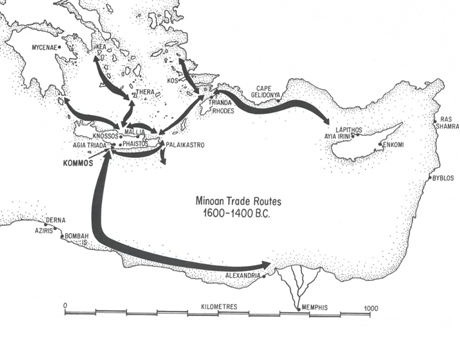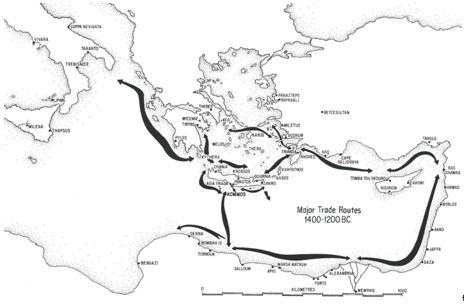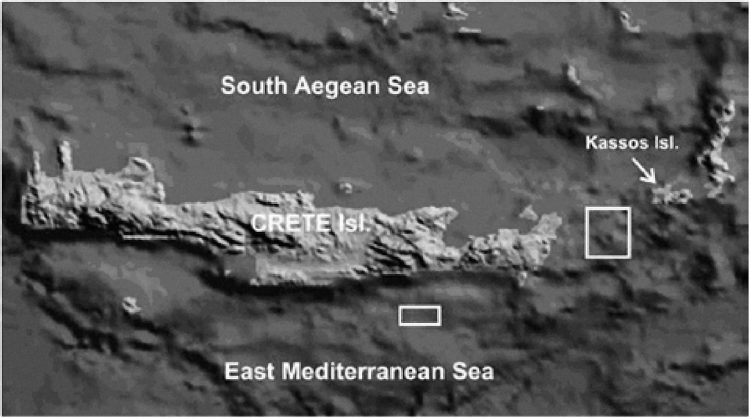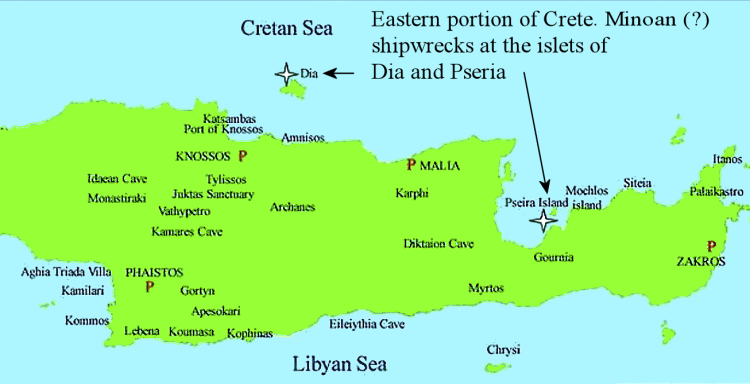A Lakonian (Minoan?) Shipwreck

Fig 1. Akrotiri Thera fresco segment. Fig 2. Minoan ship reconstruction Hania, Crete
Posted for James Stratis:
I received a tweet, copied below, of a brief notice from Bernard Knapp, Friday 11 January 2013 that made me think of L. Vance Watrous’ Kommos III – The Late Bronze Age Pottery, its trade route maps and the possibility of a Cretan connection to the Minoan shipwreck and the archaeological site of Kommos.
Knapp writes as follows in ‘A Minoan Shipwreck off Laconia’, ENALIA, 11(2012) pp 6-7:
During the summer of 2009, a research team of the Greek Ephorate of Underwater Antiquities, under the direction of the archaeologist Elias Spondylis, made an important discovery in the Koulenti area, on the Laconian coast. During an underwater archaeological survey, a wrecked cargo of the Middle Minoan III-Late Minoan I, (1700-1425 BC) period was on the rocky bottom of a steep reef. Evidently, the ceramic cargo belonged to a Minoan shipwreck, the second that has been recorded until today (after the one at Pseira islet, in the northeast of Crete) and the first that has been located outside Crete.
Among the finds that were raised from the wreck-site for further investigation, were jugs with a cut-away spout, an oval-mouthed amphora and an amphora with two horizontal cylindrical handles. It appears that the main concentration of finds has been plundered, but on the nearby sandy bottom more finds may survive.
In any case, the operational depth can allow a systematic excavation to take place. The finds have been desalinated, conserved and are now under study. The continuation of the research project at the site is expected to add new evidence for the understanding of the Minoan Thalassocracy with which the wreck at Koulenti is associated.

Kommos III is a volume focused on Kommos pottery. On pages 169-172 Watrous asks: What foreign contacts did Kommos have during the late Bronze Age and proceeds to answer, that during the Late Minoan I period in the Mesara, Phaistos, Agia Triada and Kommos were all pottery-producing centers. Pottery from Knossos reached Kommos in LMIA (1600-1480 BC). In LMIB period ( 1480-1425) Knossian vases reach Kommos in greater numbers. The quantity of Knossian vases at Kommos would seem to corroborate Arthur Evans’ suggestion that Kommos was linked directly to Knossos by a Royal Road. Watrous also documents Chanian, Eastern Cretan, Anatolian, Cypriot, Syrian, Palestinian and Egyptian wares. The largest number of imported vessels from overseas came from the Aegean Islands but the mass of Cretan pottery found in the Cyclades does not necessarily mean that they were transported by ships originating from Kommos or Crete.

When it comes to the Laconian Coast or the Greek mainland, Watrous tells us that Kommos pottery imports from the Mycenaean mainland are scarce, limited to twelve artifacts,
including this fragment from Vapheio, inland, north of the Laconian coast, south of Sparta.
Follow up web chatter over the weekend reinforces the caution of Watrous’ statement referenced above, about the origin of the ship that carried Minoan pottery. The archaeological investigative results of the Koulenti wreck and the recent analysis and virtual reconstruction at Pavlopetri, south of the wreck site, are exciting current scholastic undertakings, that potentially expands our understanding of Aegean and eastern Mediterranean trade with Crete and the port town of Kommos.


Revised 7 Febuary 2013:
Colorado University maritime archaeologist Professor Robert Hohlfelder presented his Shipwreck Survey off Southern Crete at the Denver Archaeological Institute of America (AIA) chapter in April 2008. Due to unexpected and unscheduled military priorities the intended area of study was sidetracked and reduced. The map below indicates two areas that were studied as part of the Danaos 2008 multidisciplinary project that included R. Hohlfelder, S. Wachsmann, V. Tsoukala, D. Sakellariou, D. Davis, C. Smith, B. Buxton, S. Maroulakis, G. Rousakis, P. Georgiou, P. Hale, D. Griffin, D. Theodoridou, E. Chyssocheri, and P. Fix, members from seven collaborating institutions.

As reported in the 9th Symposium on Oceanography & Fisheries, 2009 – Proceedings, Volume Ι, The aim of the survey was to document the route between Crete and Egypt in antiquity by locating, documenting and studying shipwrecks and jetsam that mark the route. Deep-submergence archaeology, enabled by advances in technology, emerged as a promising new sub-discipline of nautical archaeology. With the employment of modern surveying techniques and robots it was possible to efficiently survey and document extensive areas, and—to a limited degree—even excavate at depths inaccessible to scuba-divers. It comprised remote-sensing, a combination of nocturnal sidescan sonar and sub-bottom profiling, and visual inspection of high-interest targets by the manned submersible THETIS or the MaxRover ROV during the day. The expedition also examined the Kassian Strait to evaluate the possibility of a future survey in this area. The team did not locate any specific Minoan bronze age era wrecks or cargo south of Crete and Kommos.
Considering the unexpected delays and revised plans the Danaos team did positively locate 33 artifacts, mostly amphoras, dating from the Classical to the Late Roman/Byzantine periods. The artifacts were random finds discovered during visual inspections of anomalies that almost invariably turned out to be geological in nature. The recent breaks on many of the artifacts, together with evidence of trawling in the area visible in the sonographs, suggest that recent fishing activities have caused significant disturbances to the seafloor at depths from 400 to 800 m. Also interesting was one target represented the remains of a WWII airplane, which has been identified tentatively as a Focke-Wulf Fw-190 Würger, which entered service soon after the Battle of Crete.
In the January / February 2010 issue of the AIA periodical there was a feature article entitled First Minoan Shipwreck in which Greek archaeologist Elpida Hadjidaki recalls her dive team member Giorgos Klontzas return to the surface with his hands full of ancient pots exclaiming ‘There’s a whole world of them down there.’ The article quotes other well respected Minoan land site excavation directors Alexander MacGillivray, Jan Driessen and Phillip Betancourt (who also has several publications on Kommos pottery) about the rare bronze age shipwreck discovery. In a paper entitled The First Minoan Shipwreck: Eight Years of Study during the Eleventh International Cretological Conference in September 2011, Hadjidaki went on to disclose that the project funded by INSTAP ( an organization that has also supported Kommos stewardship) resulted in the retrieval of two hundred Middle Minoan IIB (1800-1700 BC) artifacts found at a depth of 40 – 50 meters. Eighty of them are nearly whole, but they are uniquely larger than other vessels from the same period discovered on land.
Pottery is the key to the study of archaeology in and around Kommos, providing the main chronological frameworks as well as direct insights into a range of issues from ancient economies to questions of identity and agency. The amphorae and other large jars carried liquids, probably wine or olive oil. Studies by Theotokis Theodoulou with American and Swedish scientists of the residual DNA remnants from later period Greek amphorae from the seabed also found legumes, ginger nuts, juniper and herbs such as mint, thyme and oregano. The fact that DNA from different species found in the same jars indicates that the same containers were used again and again for different goods each time. Although no wood from the Pseira ship survived, Hadjidaki concludes that the Pseira ship is between 10-15 meters long and transported cargo just around the coast of Crete. This is probably not the type of ship that ventured to the Laconian coast.

Other efforts have been made to locate Minoan ships, a team from the Euphorate of Underwater Antiquities in collaboration with the Hellenic Centre for Marine Research and Woods Hole Oceanographic Institution searched around Heraklion harbor and the islet of Dia. A team of divers did find five ancient wrecks, ranging from around the second century BC to the ninth century AD. The discoveries confirmed Jacques Cousteau’s 1976 investigative impression that the now-deserted Dia was used for centuries as an anchorage. Maritime archaeologist Brendan Foley from Woods Hole was convinced that the Minoans must have been at Dia, with the evidence perhaps on the deeper floor of islet’s bays.
For additional information on Minoan ship construction and interpretation see our,
Full Scale Minoan Ship as a Tool?,on this web site under the Articles tab.

Archontoula Papoulakou posted in ΣΥΛΛΟΓΟΣ ΦΙΛΩΝ ΤΟΥ ΙΣΤΟΡΙΚΟΥ ΑΡΧΕΙΟΥ ΤΗΣ ΑΡΧΑΙΟΛΟΓΙΚΗΣ ΥΠΗΡΕΣΙΑΣ
(HISTORICAL SOCIETY OF FRIENDS OF THE ARCHAEOLOGICAL RECORD OFFICE)
An extremely interesting lecture ….
Archontoula Papoulakou 1:32 pm Feb 12
Chr.Agouridi, Underwater research Mycenaean shipwreck on the island Modi
Tuesday, February 19, in the Building of PRI (Hermes 136).
See this article in the Athens News by Heinrich Hall.
The Modi shipwreck occurred in the transitional post Mycenaean collapse period, as determined by pottery dating to LHIIIB-LHIIIC (1230-1130BC). This is a follow up to the lecture by Christos Agouridi titled Underwater research Mycenaean shipwreck on the island Modi 12 February 2013. This report with photographs of interesting finds is published on line in the Eastern Mediterranean Maritime Archaeology Foundation web site. http://www.emmaf.org/index.php?mm=5&art_id=99
Up the Dalmatian coast from the west side of Greece another shipwreck from the Bronze Age, this one of local construction tradition.
http://www.lepoint.fr/insolite/un-bateau-de-l-age-de-bronze-retrouve-en-mediterranee-18-03-2014-1802436_48.php
The Greek Age of Bronze – Ships
http://www.salimbeti.com/micenei/ships.htm
Bodrum Museum of Underwater Archaeology
“It is likely that the ship lost at Uluburun was a royal ship- that sailed from a Near Eastern port such as Ugarit in Syria, or perhaps Cyprus, towards an unknown destination to the west”
http://roadeveron.blogspot.gr/2010/11/bodrum-museum-of-underwater-archaeology.html
“There are two other sunken boats that compete for the title of the world’s oldest, Erkanal said. The Uluburun shipwreck, found off the coast of Kaş, is around 3,500 years old, while the sunken ship of Hatshepsut, the fifth pharaoh of Ancient Egypt’s 18th dynasty, is dated to be around 150 years older”
http://www.archaeology.org/news/2509-140911-turkey-oldest-shipwreck-mediterranean
http://archaeologynewsnetwork.blogspot.com/2016/01/minoan-shipwreck-found-off-turkish-coast.html#.VsJujPJ96Cg
I referenced the Pavlopetri site in the article above. This follow up information describes what the Kommos site could also benefit from, an effort towards the conservation and park development, as described through the link below for the Pavlopetri site, in the southern area of the Peloponnese. It is from 2016, this web site indicates that the site was part of the World Monuments Fund Watch List, which is a call to action for cultural heritage sites facing imminent threats and challenges—creates opportunities for new awareness, improved protection, and positive change. Look into it here: http://www.pavlopetri.org/
ON the 29 July 2017 Director UNESCO Division for Heritage, Mechtild Rossler, twitted that there are intense discussions with participants of Pavlopetri Watch Day & encouragement to Greek authorities to ratify the 2001 Convention! The waves of conservation action are slow to return to the shore of this valuable site but at least something is happening!
David Attenborough on Facebook
 Credits to the amazing Photographer https://www.facebook.com/profile/100052432299463/search/?q=Pavlopetri
Credits to the amazing Photographer https://www.facebook.com/profile/100052432299463/search/?q=Pavlopetri
Off the coast of Laconia in south-eastern Peloponnese, Pavlopetri is a submerged prehistoric town, which consists of intact building foundations, courtyards, streets, graves, and rock-cut tombs.
It is the oldest complete town ever found underwater; the settlement contains both Neolithic and Bronze Age material and the town is believed to have flourished in the period between 3000-1000 BC.